Website owner: James Miller
APPLICATIONS: AREAS, VOLUMES OF SOLIDS OF REVOLUTION, LENGTH OF A CURVE, AREAS OF SURFACES OF REVOLUTION, WORK, FLUID PRESSURE
I Computation of area — rectangular coordinates. The area bounded by the curve y = f(x), the x-axis, and the ordinates at x = a and x = b is given by the value of
![]()
Example 1. Compute the area bounded by the curve

![]()
the x-axis, and the ordinates at x = 0 and x = 4. See Fig. 1.
Solution.
![]()

Example 2. Find the area enclosed by the curves
![]()
and 4y = x2. See Fig. 2.
Solution. The curves intersect at (
![]() 2, 1). If A is the area enclosed by them, then
2, 1). If A is the area enclosed by them, then
A = area ABCDE - area ABODE



![]()
When integration leads to an inverse trigonometric function, as in this example, one should always use the principal values.
Curve defined by parametric equations. Suppose a curve is defined by the parametric equations
x = h(t)
y = g(t)
and we wish to find the area beneath it, the x-axis and the ordinates at between x = a and x = b. Then
dx = h'(t)dt

and the area is given by

where the limits t1 and t2 are the values of t corresponding to x = a and x = b, respectively. They may be obtained from the equation x = h(t).
Example. Compute the area of the ellipse x = a cos θ, y = b sin θ. See Fig. 3.
Solution. We will find the area of the first quadrant and multiply it by 4. Since dx = (-a sin θ)dθ, we have
![]()
![]()
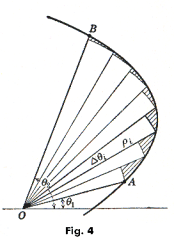
II Computation of area — polar coordinates. In rectangular coordinates we find the area bounded by the curve y = f(x), the x-axis, and the ordinates at x = a and x = b. The corresponding problem in polar coordinates is that of determining the area bounded by the curve ρ = f(θ) and the two radius vectors θ = θ1 and θ = θ2. In Fig. 4 this is the area bounded by the curve and the lines OA and OB.
The procedure is as follows: We divide the θ-interval from θ = θ1 to θ = θ2 up into n subintervals (not necessarily equal) having the magnitudes Δθ1, Δθ2, ... ,Δθn . We then draw the corresponding radius vectors, denoting their lengths by ρ1, ρ2, ... , ρn, and draw the circular arcs as shown.
Remembering that the area of a circular sector having radius r and central angle α is ½ r2α , we write down the following expression for the sum of the areas of the circular sectors:
![]()
The area bounded by the curve and the lines OA and OB is then equal to the limit of the following sum

where we are requiring that the largest Δθi → 0 as n → ∞.
Theorem. The area bounded by the curve whose polar equation is ρ = f(θ) and the two radius vectors θ = θ1 and θ = θ2 is given by
![]()
In general, when we perform an integration using this theorem we replace ρ in the integrand with f(θ). The area A will be positive (assuming ρ is real) if the integration is in the counterclockwise sense i.e. if θ1 < θ2. If it is performed in the clockwise sense, θ1 > θ2, the value of the integral will be negative.
Example 1. Find the area that is common to the circle ρ = 3 cos θ and the cardioid ρ = 1 + cos θ. See Fig. 5.
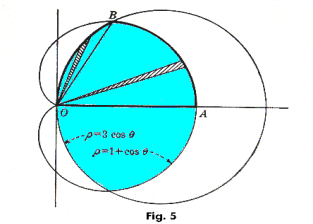
Solution. The curves intersect at the
origin and at polar coordinates ( 3/2,
![]() π/3). The required area is twice the area
bounded by OA, arc AB of the cardioid,
and arc BO of the circle. The area
bounded by the radius vectors OA and OB
and arc AB of the cardioid is given by
π/3). The required area is twice the area
bounded by OA, arc AB of the cardioid,
and arc BO of the circle. The area
bounded by the radius vectors OA and OB
and arc AB of the cardioid is given by
![]()
The area bounded by radius vector OB and arc OB of the circle is given by
![]()
Adding these up and doubling the result, we find that A = 5π/4.
One can think of the area as being generated by the shaded “differential area element” shown in the figure revolving in a counterclockwise fashion. From θ = 0 to θ = ⅓π the outer end of the element is on the arc AB of the cardioid; from θ = ⅓π to θ = ½π the outer end is on arc BO of the circle.
Example 2. Compute the area bounded by the curve ρ = a sin 3θ. See Fig. 6.
Solution. If we want we can compute the area of one leaf by integrating from θ = 0 to θ = ⅓π, and then multiply by 3:


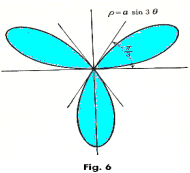
Alternatively, we could have obtained the area by integrating from θ = 0 to π. Thus

Volumes of solids of revolution.
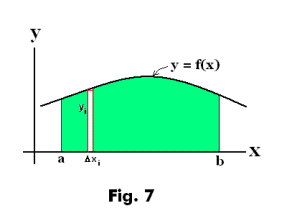
Disk method. Let us suppose the area shown in green in Fig. 7, bounded by the curve y = f(x), the x-axis, and the ordinates at x = a and x = b, is revolved about the x-axis so as to create the barrel shaped solid shown in Fig. 8. We wish to find the formula for the volume of the solid thus generated.
Derivation of the formula. If the rectangle with base Δxi and height yi shown in Fig. 7 is revolved about the x-axis it generates a cylindrical disk of radius yi and thickness Δxi whose volume is πyi 2Δxi. If the interval [a, b] is partitioned into n subintervals, then the sum of the volumes of the n disks thus generated is

The volume of the solid is then given by
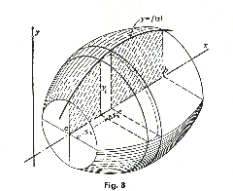

Theorem 1. If the area bounded by the curve whose equation is y = f(x), the x-axis, and the ordinates at x = a and x = b is revolved about the x-axis, the volume generated is given by
![]()
Similarily, if the area bounded by the curve x = f(y), the y-axis, and the lines y = c and y = d is revolved about the y-axis, the volume generated is given by the formula
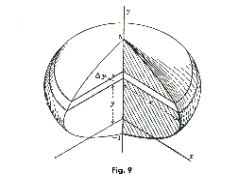
![]()
Example. Compute the volume generated by revolving the area bounded by the y-axis and the parabola y2 - 4y + 2x - 5 = 0 about the y-axis. See Fig. 9.
Solution. Setting x = 0 and solving for y, we find that the parabola crosses the y-axis at y = -1 and y = 5. The volume is given by
![]()
The cylindrical shell method. There is another method for computing volumes of surfaces of revolution that is in some cases simpler than the disk method. Consider the solid of revolution shown in Fig. 10 obtained by revolving one arch of the sin function y = sin x about the y-axis. If we chose to use the disk method in computing the volume, each disk would have a hole in it (it would look like a washer). A simpler method is to revolve each vertical strip, base Δxi and height yi, about the y-axis generating a thin cylindrical shell of inside radius xi, height yi, and
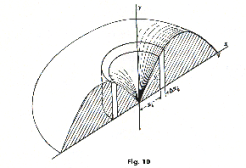
thickness Δxi as shown in the figure. The volume of such a shell is approximately equal to (2πxi)yiΔxi. If we partition the interval [a, b] on the x-axis over which we wish to integrate into n subintervals then the sum of the volumes of the cylindrical shells is given approximately by

The volume of the solid is then given by

Theorem 2. Let an interval [a, b] on the x-axis be on one side of the origin or the other, but not overlapping it, and let a < b. If the area bounded by the curve whose equation is y = f(x), the x-axis, and the ordinates at x = a and x = b is revolved about the y-axis, the volume generated is given by
![]()
The type of analysis, way of thinking, that we have just employed can be used to find volumes for a diverse assortment of volume-of-revolution type problems.
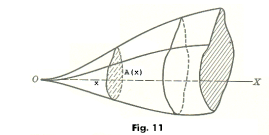
Volumes of solids with known cross sections. Suppose we have a solid whose cross sections perpendicular to the x-axis have areas that are functions of the variable x i.e. the area of the cross section at distance x from the origin is given by A(x). See Fig. 11. In this case the volume of the solid is given by
![]()
Note that the disk method of computing volumes is a special case of this method. The disk method amounts essentially to viewing the solid as being made up of thin slices created by passing parallel planes perpendicular to its axis. In the disk method A(x) = πy2.
Example. Consider the conoid shown in Fig. 12. Its base is the circle x2 + y2 = r2 and its “vertex” is a line segment parallel to the base, at a distance h above it, and of length 2r. The surface is generated by an element that moves so as to intersect both the circle and this line segment and remain parallel to the yz-plane.
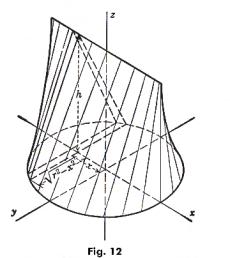
At a distance x from the yz-plane, the section of this solid is a triangle whose base is
![]() and whose altitude is the constant h. The area of this section, expressed in terms of x, is
and whose altitude is the constant h. The area of this section, expressed in terms of x, is
![]()
The volume of the conoid is then given by
![]()
Length of a curve.
Rectangular coordinates.
Differential of arc length. The differential of arc length ds is given by
![]()


Length of a curve. The length of a segment of a curve is given by


![]()
Polar coordinates.
Differential of arc length.
![]()


Length of a curve.


******************************************
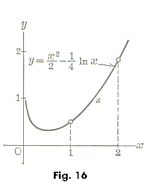
Example 1. Find the length of the curve

between points for which x = 1 and x = 2. See Fig. 16.
Solution. Since

we have

Example 2. Compute the perimeter of the circle ρ =2a sin θ. See Fig.17.
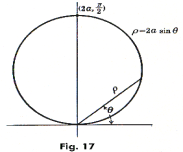
Solution. Since
![]()
we have
![]()
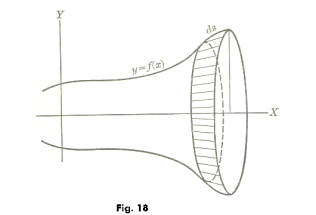
Area of a surface of revolution. When the curve y = f(x) is revolved about the x-axis, a surface is generated. See Fig. 18. To find the area of this surface we consider the area generated by an element of arc ds. The area generated by an element of arc ds is given by
dS = 2πy ds.
Summing all such elements of surface area we get
![]()

Example. Compute the area of the spherical surface generated by revolving the upper half of the circle x2 + y2 = r2 about the x-axis.
Solution.



Work. Let a body move along a straight line under the application of a constant force. The product of the magnitude of the force and the distance moved is called the work done on the body during the motion. In symbols, the work done is given by the formula
W = Fd

where W is the work done, F is the applied force, and d is the distance moved. Thus the work done by the 20 lb. force indicated in Fig. 19 in pushing the block a distance of 12 ft. is 20(12) = 240 ft-lbs.
Work done by a variable force acting along a curve. Let us now generalize our notion of work to consider a variable force acting in the direction of motion which takes place along some curve C. The distance along the curve from some fixed initial point A to some point P is s. The differential element is ds. If the force F is a function of s, then the differential element of work done will be dW = F(s) ds. Summing all such elements we get the total work done between points S1 and S2 on the curve:
![]()
Example. The force required to stretch a spring is directly proportional to the elongation. If a force of one pound stretches the spring half an inch, what is the work done in stretching the spring 2 inches?
Solution. Call L the natural length of the spring and x the elongation. The applied force F and elongation x are related by F = kx where k is the constant of the spring. First we must find the value of k. Plugging our given values for F and x into F = kx we get
![]()
or
k = 2.
Hence F = 2x and the work done is
![]()
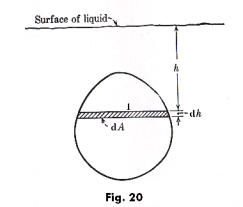
Fluid pressure. At any point in a fluid there exists a pressure (say, lbs./sq. ft.) arising from the weight of the fluid above it. Envision a vertical column of liquid 1 ft. x 1 ft. in cross section. The pressure in lbs./sq. ft. at any point in the column is due to the weight of the liquid above it. Just as a stack of cement blocks exerts a pressure on the surface beneath it, even so a column of fluid exerts a pressure. The formula giving this pressure is
p = wh
where p is the pressure at the point, h is the depth below the surface, and w is the density of the fluid (i.e. weight of the fluid per unit volume).
Problem. Compute the total force exerted by a fluid on one side of a vertical surface (such as, for example, a vertical side of a dam) submerged in the fluid.
Solution. Consider the submerged vertical surface shown in Fig. 20. Consider a horizontal strip of length l and depth h on this surface as shown in the figure. Let this strip be of width dh. Then the area dA of the strip is l dh and the pressure on it is wh. The force exerted by the fluid on this strip is pressure x area or dF = wh dA = whl dh. Therefore the total force exerted by the fluid on the submerged vertical surface will be given by
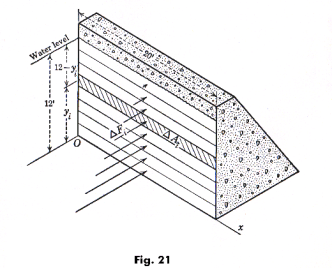
![]()
This integral can be evaluated once l is expressed as a function of h, l = f(h).
Example 1. Given the dam shown in Fig. 21. The dam is 20 ft. long. Find the total force exerted against the face of the dam when the water in 12 ft. deep.
Solution. The area of a strip is given by
dA = 20 dy (sq. ft.)
In the coordinate system shown in the figure the depth of the strip below the water surface is “12 - y” ft. and the pressure at this depth is w(12 - y) lbs./sq. ft. The pressure against the strip is then
wh dA = w(12 - y)(20 dy) lbs.
The total force against the face of the dam is then
![]()
References.
Middlemiss. Differential and Integral Calculus.
Oakley. The Calculus.
Smith, Salkover, Justice. Calculus.
Jesus Christ and His Teachings
Way of enlightenment, wisdom, and understanding
America, a corrupt, depraved, shameless country
On integrity and the lack of it
The test of a person's Christianity is what he is
Ninety five percent of the problems that most people have come from personal foolishness
Liberalism, socialism and the modern welfare state
The desire to harm, a motivation for conduct
On Self-sufficient Country Living, Homesteading
Topically Arranged Proverbs, Precepts, Quotations. Common Sayings. Poor Richard's Almanac.
Theory on the Formation of Character
People are like radio tuners --- they pick out and listen to one wavelength and ignore the rest
Cause of Character Traits --- According to Aristotle
We are what we eat --- living under the discipline of a diet
Avoiding problems and trouble in life
Role of habit in formation of character
Personal attributes of the true Christian
What determines a person's character?
Love of God and love of virtue are closely united
Intellectual disparities among people and the power in good habits
Tools of Satan. Tactics and Tricks used by the Devil.
The Natural Way -- The Unnatural Way
Wisdom, Reason and Virtue are closely related
Knowledge is one thing, wisdom is another
My views on Christianity in America
The most important thing in life is understanding
We are all examples --- for good or for bad
Television --- spiritual poison
The Prime Mover that decides "What We Are"
Where do our outlooks, attitudes and values come from?
Sin is serious business. The punishment for it is real. Hell is real.
Self-imposed discipline and regimentation
Achieving happiness in life --- a matter of the right strategies
Self-control, self-restraint, self-discipline basic to so much in life